Abstract
Thermal stress relief (TSR), vibration stress relief (VSR), and thermal and vibratory Stress relief (TVSR) have all been proven to be effective for residual stress relief. So far, no comparison has been made between the effects on residual stress relief of these three stress release methods. In this study, twelve 2219 aluminum alloy welding samples were divided into four groups. One of the groups is used as a reference without any stress relief treatment. The other three groups were processed by TSR, VSR, and TVSR, respectively. The residual stresses of depths of 0–1.2 mm are measured. Results show that small and uniform stresses are observed in the 2219 aluminum alloy welding samples after TSR, VSR, and TVSR treatment. TSR treatment decreased the peak residual stress much more than VSR and TVSR treatment. The maximum reduction of the peak residual stress is 50.8% (210 °C) in the transversal direction and 42.02% (185 °C) in the longitudinal direction after TSR treatment with the temperature range 140 °C to 210 °C. In terms of residual stress homogenization, although the TSR treatment has an advantage perpendicular to the weld direction, the effect parallel to the weld direction is not ideal. The TVSR has a good effect in both directions.
1. Introduction
In spacecraft tanks, 2219 Aluminum Alloy is widely used for its excellent high and low temperature mechanical properties, and strong stress corrosion cracking resistance [1]. Due to the shape requirements, many 2219 Aluminum Alloy components need to be connected by means of welding. Significant and uneven distribution residual stress is inevitably induced inside the welded components for its local non-uniform heating and cooling process [2,3]. The residual stress and the working stress caused by the load are superimposed on each other during the service of the weldment, causing secondary deformation and redistribution of residual stress, which not only reduces the rigidity and dimensional stability of the welded structure, but also the fatigue strength, brittle fracture resistance, resistance to stress corrosion cracking, and high temperature creep cracking of the structure will be seriously affected [4,5,6]. These effects are very unfavorable for structural performance, safety, and reliability of welded components. Thus, stress relief is a necessary technology before welding components are used. The most commonly used residual stress relief methods are thermal stress relief (TSR) and vibration stress relief (VSR).
TSR refers to the process of relieving residual stress under temperature by heating, holding, and cooling the parts for a certain time. Bruno et al. [7] studied the residual stress distribution and microscopic changes after isothermal annealing treatment of metal matrix composites by means of neutron diffraction. In order to adjust the residual stress state of the satellite box and reduce the processing deformation, Younger et al. [8] studied the quenching process, mechanical deformation treatment, and thermal aging treatment of the two aluminum alloys, thus effectively solving the problem. Tanner et al. [9] performed a thermal aging treatment at 170 °C for 12 h on the forging of aluminum alloy 2014 after solution treatment, and the results show that the residual stress amplitude decreased. Edwards et al. [10] evaluated the residual stress state of the weld seam after 45 min of post-weld thermal stress relief of the weld at 760 °C. The results show that the post-weld thermal stress relief can effectively reduce the residual stress caused by welding.
VSR works by applying a cyclic load for a certain time. Hebel et al. [11] studied the effect of VSR at sub-resonance frequencies on the residual stress relief of welded structures. The article considers that the sub-resonance frequency is the preferred excitation frequency for the residual stress release of the weldment. Rao et al. [12] established a mathematical model of residual stress relaxation under dynamic stress, proving that the evaluation of the effect of vibration aging by dynamic stress is feasible. Kwofier [13] pointed out that the residual stress is self-balancing and the release of local stress causes the stress of the part to be redistributed, and a plastic model was constructed to simulate the VSR phenomenon. Djuric et al. [14] studied VSR treatment on the residual stresses for welded specimens of ultra-high strength steel. The results show that VSR treatment has a limited effect on the macroscopic residual stress state but significantly increases the damage of the microstructure. Li et al. [15] studied the effect of VSR on the welded components of DH36 high strength low alloy steel, with the results showing that the residual stress of the weld toe is reduced by 29–72% after VSR treatment; the metallographic structure is not changed much, but the dislocations increase. Sonsino et al. [16] pointed out that the fatigue life of the parts after VSR is equivalent to that after high temperature thermal aging, but the residual stress elimination effect is not as good as the thermal aging.
The Thermal and Vibratory Stress Relief (TVSR) is a combined method of TSR and VSR. Under a certain temperature (the organization and mechanical behavior of the workpiece should not be affected), a cyclic dynamic load is applied to a workpiece to achieve the relief and homogenization of the residual stress. Lv et al. [17] compared the residual stress release effects of TVSR and VSR treatment and the experimental results showed that the maximum stress in the high stress region after TVSR treatment was reduced by 55.9%, which is greater than the result after VSR treatment. Li et al. [18] applied the waste heat to VSR during a multi-pass welding procedure, with the result indicating that the method seems more effective in decreasing the residual stress.
As can be seen from the above studies, TSR, VSR, and TVSR treatment have all been proven to be effective for residual stress relief. So far, no comparison has been made between the effects on residual stress relief of these three stress release methods. In addition, due to the rapid heat input and cooling during the welding process, the residual stress has a distribution unevenness in the direction perpendicular to the weld seam and along the depth direction of the weld component. However, most of the current research focuses on the evaluation of the effect on residual stress relief and homogenization on the surface of the weld parts. In this study, twelve 2219 aluminum alloy welding samples were divided into four groups. One of the groups is used as a reference without any stress relief treatment. The other three groups were processed by TSR, VSR, and TVSR, respectively. The residual stresses of depths of 0–1.2 mm are measured to compare the relief and homogenization in stress.
2. Materials and Methods
2.1. Welding Samples
The overall size of the welded sample is 300 mm × 300 mm × 8 mm (length × width × height), which is formed by arc welding of two identical 2219 Aluminum Alloy-C10S sheets on a welding platform. The welding platform and the structure of the welded assembling is schematically shown in Figure 1. The welded sample is placed under the clamping device and two plate clamping devices are fixed on the platform by four bolts. The distance from the side of the plate clamping device to the centerline of the weld seam is 25 mm. The measurement points of the residual stress are arranged 63 mm from the end of the welding. There are 4 measuring points, P1, P2, P3, and P4, located 0 mm, 15 mm, 30 mm, and 45 mm from the center of the weld seam, respectively. Six measurement values are taken along the depth direction of each measurement point, which are located at depths of 0.2 mm, 0.4 mm, 0.6 mm, 0.8 mm, 1.0 mm, and 1.2 mm, wherein the transversal direction represents a direction perpendicular to the weld seam, and the longitudinal direction represents a direction parallel to the weld seam. The chemical composition of the 2219 Aluminum Alloy used in this study is shown in Table 1 [19]. Specific welding parameters and the filler materials are listed in Table 2.
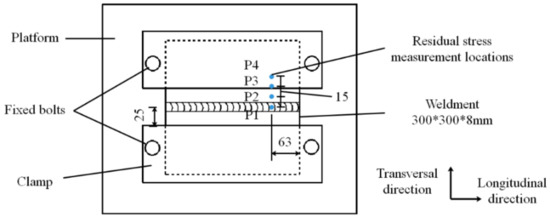
Figure 1.
Schematics of the structure of the welded assembling.

Table 1.
Chemical composition of the 2219 Aluminum Alloy. (wt.%).

Table 2.
Parameters of the welding procedure.
2.2. Experiment Scheme
In this study, twelve 2219 Aluminum Alloy welding samples were divided into four groups. As shown in Figure 2, one of the samples, called Group O, is used as a reference without any stress relief treatment. The temperature of TSR treatment must be lower than the recrystallization temperature of the alloy. Thus, the TSR treatment with temperatures of 140 °C, 185 °C, and 210 °C are conducted on the samples in Group A and maintained for 8 h [20]. In order to prevent residual stress from being introduced due to uneven cooling, the samples are cooled to room temperature in a furnace.
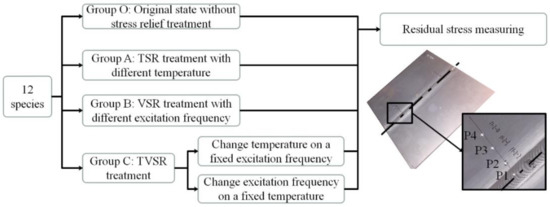
Figure 2.
Grouping conditions of the residual stress relief tests.
The samples of Group B are used for VSR treatment with different excitation frequencies. The selected excitation frequencies are 40 Hz, 56 Hz, and 72 Hz, corresponding to sub-resonance frequency, resonance frequency, and over-resonance frequency, respectively. The vibration time for each specimen is 10 min [21]. Among them, 56 Hz is the first order resonance frequency, which was determined by hammer measurement. The hammering experiment uses a high-precision network dynamic signal acquisition and analysis system from the company Yi Yang, model JC-1.
TVSR treatments are performed on the samples in Group C. Specifically, it is further divided into two groups. One group has a fixed temperature at 185 °C, with changes in the excitation frequency (40 Hz, 56 Hz, and 72 Hz). The other group has a fixed excitation frequency at 56 Hz, with changes in the temperature (140 °C, 185 °C, and 210 °C). In the TVSR experiment, the samples are maintained at a preset temperature for 2 h, then the vibration exciter is turned on to start vibration for 10 min. The samples in Group C are cooled to room temperature in a furnace.
2.3. Experimental Equipments
The experimental device is self-designed and consists mainly of a vibration system and a thermal system shown in Figure 3. The thermal system covers the vibration system. When TSR treatment is carried out, the vibration controller turns off. The thermal system turns off when the VSR is conducted. When the TSVR is in progress, the vibration system and the thermal system work simultaneously.
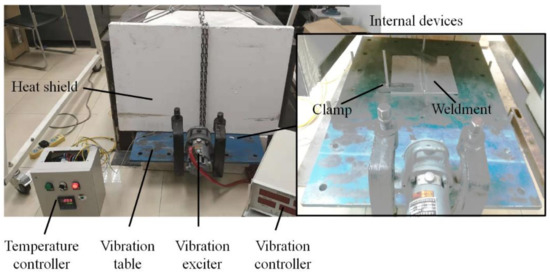
Figure 3.
Vibration system and Thermal system.
The residual stress was measured by a Prism residual stress instrument manufactured by the Stress Tech Group of Finland, which is a residual stress measurement device based on the hole-drilling method and electronic speckle pattern interferometry technique [21], as shown in Figure 4. A carbide tool with a diameter of 3.175 mm is used in the experiment. The cutting speed is 20,000 r/min.
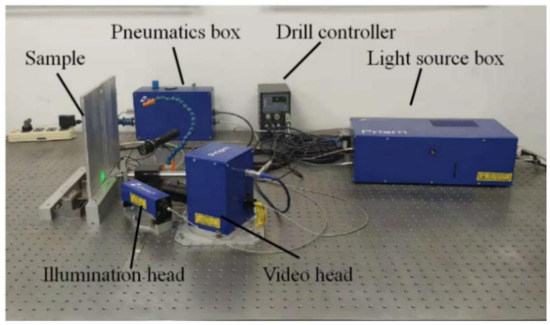
Figure 4.
Residual stress test setup.
3. Results and Discussion
3.1. TSR Treatment with Different Temperatures
Figure 5 shows the residual stresses at the four-measurement points before and after TSR treatment at different temperatures. The average and peak residual stress at four measuring points in Group O were much larger than Group A. This indicates that TSR treatment can effectively reduce the magnitude of residual stress in 2219 aluminum alloy weldment. In the transversal direction, the peak residual stress in Group O was −81.3 MPa. The values decreased to −41.2, −40.9, and −40 MPa after TSR treatment with temperatures of 140 °C, 185 °C, and 210 °C, respectively, and the maximum reduction was 50.8% (210 °C). In the longitudinal direction, the peak value of residual stress without treatment is 71.4 MPa. The values reduced to 60.6, 41.4, and 57.1 MPa after TSR treatment with temperatures of 140 °C, 185 °C, and 210 °C, respectively, and the maximum decreased by 42.02% (185 °C). Although the temperature range of the TSR treatment was from 140 to 210 °C, changes in peak stress of 2219 aluminum alloy weldments do not show any regularity.
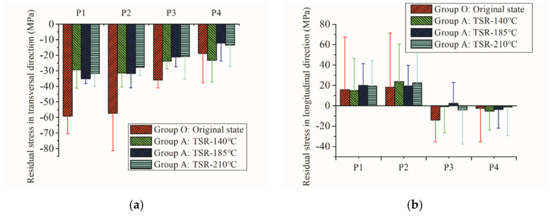
Figure 5.
Residual stresses in the transversal direction (a) and longitudinal direction (b) at each measurement point, before and after thermal stress relief (TSR) treatment at different temperatures (each bar represents the average values along the depth direction, and the one with the largest amplitude among the six measured values is expressed by the error bars.).
Table 3 shows the standard deviation and mean value of the average stresses at four measuring points, before and after TSR at different temperatures. When TSR treatment is conducted at 140 °C, the standard deviation in the transversal direction is reduced by a maximum of 78.32%. In the longitudinal direction, the standard deviation decreased by a maximum of 22.1% for TSR treatment at 185 °C. Although the peak and standard deviation were used as the basis for evaluation of stress release and homogenization, the average value was given. This may be helpful for some readers and researchers.

Table 3.
Standard deviation and mean value of the average stress at four measuring points before and after TSR at different temperatures. Unit: MPa.
3.2. VSR Treatment with Different Excitation Frequency
Figure 6 shows the residual stress at the four measurement points, before and after VSR at different vibration frequencies. In the transversal direction, the peak residual stresses in Group A were −54.1, −47.2, and −43.8 MPa after VSR treatment with excitation frequencies of 40 Hz, 56 Hz, and 72 Hz, respectively. The maximum reduction was 46.1% (72 Hz) compared to the welded parts in Group O. In the longitudinal direction, the peak residual stresses in Group A were 63.8, 52.9, and 50.9 MPa after VSR treatment with excitation frequencies of 40 Hz, 56 Hz, and 72 Hz, respectively. The maximum reduction was 28.7% (72 Hz).
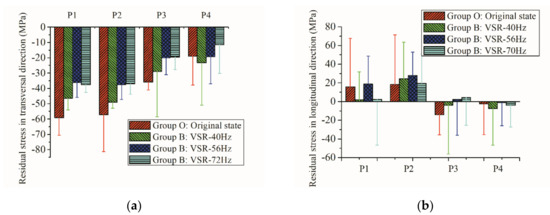
Figure 6.
Residual stresses in the transversal direction (a) and longitudinal direction (b) at each measurement point, before and after vibration stress relief (VSR) treatment at different temperature.
By comparing the three sets in Group B, it can be found that the larger frequency decreases the peak stress much more when the excitation frequency is in the range of 40–72 Hz. The peak residual stress changes at each stress measuring point also had this pattern. It is worth noting that the stress of the 2219 aluminum alloy welded part after the excitation frequency of 40 Hz (sub-resonance frequency) VSR was significantly reduced at the points where the stress was large in Group O (P1, P2). However, at point P4, the mean and peak stress was instead higher than that without any treatment. This was probably due to scattering in the initial residual stresses after welding.
Table 4 shows the standard deviation and mean value of the average stresses at four measuring points, before and after VSR at different temperatures. When VSR treatment was conducted at 56 Hz, the standard deviation in the transversal direction was reduced by a maximum of 47.83%. In the longitudinal direction, the standard deviation decreased by a maximum of 34.64% for VSR treatment at 72 Hz.

Table 4.
Standard deviation and mean value of the average stress at four measuring points, before and after VSR at different temperatures. Unit: MPa.
3.3. TVSR Treatment with Different Excitation Frequencies and Temperatures
Figure 7 shows the residual stress at each measurement point before and after TVSR. In the transversal direction, the peak residual stresses in Group C were −65.9, −43.6, −53.2, −46.2, and −53.4 MPa after TVSR treatment with parameters of 185 °C-40 Hz, 185 °C-56 Hz, 185 °C-72 Hz, 210 °C-56 Hz, and 140 °C-56 Hz, respectively. The maximum reduction was 46.37% (185 °C-56 Hz) compared to the welded parts in Group O. In the longitudinal direction, the peak residual stresses in Group A were 55.2, −46.1, −46.6, 53.9, and 55.1 MPa after VSR treatment with parameters of 185 °C-40 Hz, 185 °C-56 Hz, 185 °C-72 Hz, 210 °C-56 Hz, and 140 °C-56 Hz, respectively. The maximum reduction of amplitude of stress was 35.43% (185 °C-56 Hz).
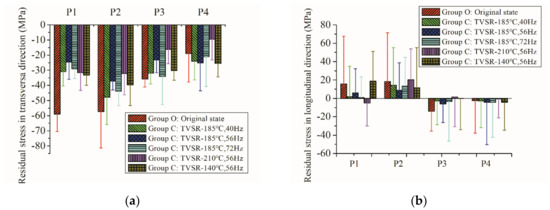
Figure 7.
Stresses in the transversal direction (a) and longitudinal direction (b) at each measurement point, before and after thermal and vibratory Stress relief (TVSR) treatment at different parameters.
Among the five selected parameters, there was no obvious change in the peak stress, whether it was only changing the frequency or only changing the temperature. A moderate temperature at the resonant frequency (185 °C-56 Hz) is more advantageous in the release of residual stress by TSVR treatment in both transversal and longitudinal directions.
Table 5 shows the standard deviation of the average stresses at four measuring points before and after TVSR at different temperatures. After TVSR processing, the standard deviation was reduced regardless of which set of parameters was used. The standard deviation was reduced by a maximum of 69.15% (140 °C-56 Hz) in the transversal direction, and reduced by a maximum of 51.86% (185 °C-56 Hz) in the longitudinal direction. Mean values are given in Table 6.

Table 5.
Standard deviation of the average stress at four measuring points, before and after TVSR at different parameters. Unit: MPa.

Table 6.
Mean values of the average stress at four measuring points, before and after TVSR at different parameters. Unit: MPa.
Through the experimental study of three sets of stress relief treatments on 2219 aluminum alloy welded parts, it can be found that all the TSR, VSR, and TVSR treatments can reduce the peak residual stress. By measuring the uniformity of the stress with the standard deviation, it was found that the stresses were more uniform.
Specifically, after TSR processing, the peak stress is reduced the most, TVSR is second, and VSR is the least. In terms of residual stress homogenization, although the TSR treatment has an advantage perpendicular to the weld direction, the effect parallel to the weld direction is not ideal. The TVSR has a good effect in both directions. By comparing Figure 6 with Figure 7, and Table 4 and Table 5, it can be seen that the 2219 aluminum alloy welded parts subjected to the aging treatment have more uniform stress at the same excitation frequency. By comparing Figure 5 and Figure 7, and Table 3 and Table 5, at the same temperature it can be seen that the residual stress in both directions is more uniform only when the resonance frequency is applied, while the applied frequency does not have an advantage in reducing the peak stress. However, it is noted that the processing time is only 2 h, while the TSR need 8 h.
4. Conclusions
In this study, twelve 2219 aluminum alloy welding samples were divided into four groups. One of the groups is used as a reference without any stress relief treatment. The other three groups were processed by TSR, VSR, and TVSR, respectively. The residual stresses at depths of 0–1.2 mm are measured. The primary contributions and conclusions of this work are as follows:
- Small and uniform stresses are observed in the 2219 aluminum alloy welding samples after TSR, VSR, and TVSR treatment.
- TSR treatment decreased the peak residual stress much more than VSR and TVSR treatment. The maximum reduction of the peak residual stress was 50.8% (210 °C) in the transversal direction and 42.02% (185 °C) in the longitudinal direction after TSR treatment with the temperature ranging from 140 to 210 °C.
- The larger frequency indicates a small peak stress when the excitation frequency is in the range of 40–72 Hz. The peak residual stress changes at each stress measuring point also show this pattern.
- A moderate temperature at the resonant frequency (185 °C-56 Hz) is more advantageous in the release of residual stresses in both transversal and longitudinal directions by TSVR treatment.
- In terms of residual stress homogenization, although the TSR treatment has an advantage perpendicular to the weld direction, the effect parallel to the weld direction is not ideal. The TVSR has a good effect in both directions.
Author Contributions
S.-G.C., Y.-D.Z., and H.-J.G. conceived and designed the experiments; S.-G.C. and H.-J.G. performed the experiments; S.-G.C. and Q.W. analyzed the data; S.-G.C. and Q.W. wrote the paper; S.-G.C., H.-J.G. and D.-Y.Y. revised the paper.
Funding
This work is supported by State Key Laboratory of Virtual Reality Technology Independent Subject (VRLAB2018P07), The National Natural Science Foundation of China (51875024, U1637601).
Acknowledgments
This work is supported by State Key Laboratory of Virtual Reality Technology Independent Subject (VRLAB2018P07), The National Natural Science Foundation of China (51875024, U1637601). The authors thank the referees of this paper for their valuable and very helpful comments.
Conflicts of Interest
The authors declare no conflict of interest.
References
- Muraca, R.F.; Whittick, J.S. Materials Data Handbook: 2219 Aluminum Alloy; NASA Marshall Space Flight Center: Washington, DC, USA, 1972. [Google Scholar]
- Qureshi, E.M.; Malik, A.M.; Dar, N.U. Residual stress fields due to varying tack welds orientation in circumferentially welded thin-walled cylinders. Adv. Mech. Eng. 2009, 1, 588–593. [Google Scholar] [CrossRef]
- Kim, H.J.; Kim, Y.D.; Lee, D.H. Scheduling for an arc-welding robot considering heat-caused distortion. J. Oper. Res. Soc. 2005, 56, 39–50. [Google Scholar] [CrossRef]
- Benedetti, M.; Fontanari, V.; Scardi, P.; Ricardo, C.L.A.; Bandini, M. Reverse bending fatigue of shot peened 7075-T651 aluminium alloy: The role of residual stress relaxation. Inter. J. Fatigue 2009, 31, 1225–1236. [Google Scholar] [CrossRef]
- Hadidi-Moud, S.; Mahmoudi, A.H.; Truman, C.E.; Smith, D.J. Combined effect of residual stress and loading history on brittle fracture. Mod. Phys. Lett. A 2003, 18, 1273–1285. [Google Scholar]
- Yu, J.; Yu, J.; Gou, G.; Zhang, L.; Zhang, W.; Chen, H.; Yang, Y.P. Ultrasonic impact treatment to improve stress corrosion cracking resistance of welded joints of aluminum alloy. J. Mater. Eng. Perform. 2016, 25, 3046–3056. [Google Scholar] [CrossRef]
- Bruno, G.; Fernández, R.; González-Doncel, G. Relaxation of the residual stress in 6061Al-15 vol.% SiCw composites by isothermal annealing. Mater. Sci. Eng. A 2004, 382, 188–197. [Google Scholar] [CrossRef]
- Younger, M.S.; Eckelmeyer, K.H. Overcoming Residual Stresses and Machining Distortion in the Production of Aluminum Alloy Satellite Boxes. No. SAND2007-6811; Sandia National Laboratories: Albuquerque, NM, USA, 2007.
- Tanner, D.A.; Robinson, J.S. Reducing residual stress in 2014 aluminium alloy die forgings. Mater. Des. 2008, 29, 1489–1496. [Google Scholar] [CrossRef]
- Edwards, P.; Ramulu, M. Surface residual stresses in Ti-6Al-4V friction stir welds: pre- and post-thermal stress relief. J. Mater. Eng. Perform. 2015, 24, 1–8. [Google Scholar] [CrossRef]
- Hebel, A.G. Subresonant vibrations relieve residual stress. Metal Progr. 1985, 128, 51–55. [Google Scholar]
- Rao, D.; Wang, D.; Chen, L.; Ni, C. The effectiveness evaluation of 314L stainless steel vibratory stress relief by dynamic stress. Inter. J. Fatigue 2007, 29, 192–196. [Google Scholar] [CrossRef]
- Kwofie, S. Plasticity model for simulation, description and evaluation of vibratory stress relief. Mater. Sci. Eng. A 2009, 516, 154–161. [Google Scholar] [CrossRef]
- Djuric, D.I.D.; Kerschbaumer, D.I.K. Vibration stress relief treatment of welded high-strength martensitic steel. Weld. World 2011, 55, 86–93. [Google Scholar] [CrossRef]
- Li, S.Q.; Fang, H.Y.; Liu, X. Influence of vibration stress relief (VSR) on the residual stress and microstructure in welded plate of DH36 low alloy high strength steel. Adv. Mater. Res. 2014, 887, 924–928. [Google Scholar] [CrossRef]
- Sonsino, C.M.; Müller, F.; Back, J.; de Back, J.; Gresnigt, A.M. Influence of stress relieving by vibration on the fatigue behaviour of welded joints in comparison to post-weld heat treatment. Fatigue Fract. Eng. Mater. Struct. 2010, 19, 703–708. [Google Scholar] [CrossRef]
- Lv, T.; Zhang, Y. A combined method of thermal and vibratory stress relief. J. Vibroeng. 2015, 17, 2837–2845. [Google Scholar]
- Li, S.Q.; Fang, H.Y.; Liu, X.S.; Wang, P.; Ma, R.; Cui, W. Inter-Pass Thermal-Vibration Stress Relief on Multi-Pass Welded Joints of DH 36 Steel. In Proceedings of the International Conference on Advanced Material Science and Engineering, Chiang Mai, Thailand, 26–27 June 2016. [Google Scholar]
- Zhang, D.; Li, Q.; Zhao, Y.; Liu, X.; Song, J.; Wang, G.; Wu, A. Microstructure and mechanical properties of three-layer TIG-welded 2219 aluminum alloys with dissimilar heat treatments. J. Mater. Eng. Perform. 2018, 27, 2938–2948. [Google Scholar] [CrossRef]
- Ding, J.K.; Wang, D.; Ying, W.; Du, H. Effect of post weld heat treatment on properties of variable polarity TIG welded AA2219 aluminium alloy joints. Trans. Nonferrous Met. Soc. China 2014, 24, 1307–1316. [Google Scholar] [CrossRef]
- Gao, H.J.; Zhang, Y.D.; Wu, Q.; Song, J. Experimental investigation on the fatigue life of Ti-6Al-4V treated by vibratory stress relief. Metals 2017, 7, 158. [Google Scholar] [CrossRef]
© 2019 by the authors. Licensee MDPI, Basel, Switzerland. This article is an open access article distributed under the terms and conditions of the Creative Commons Attribution (CC BY) license (http://creativecommons.org/licenses/by/4.0/).